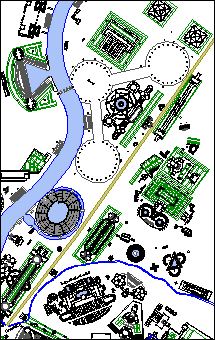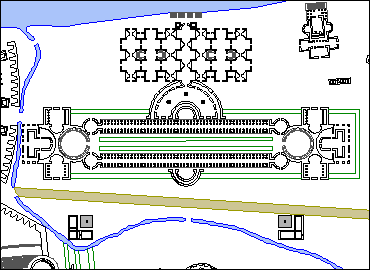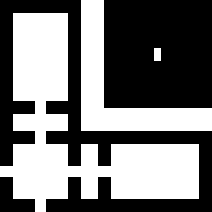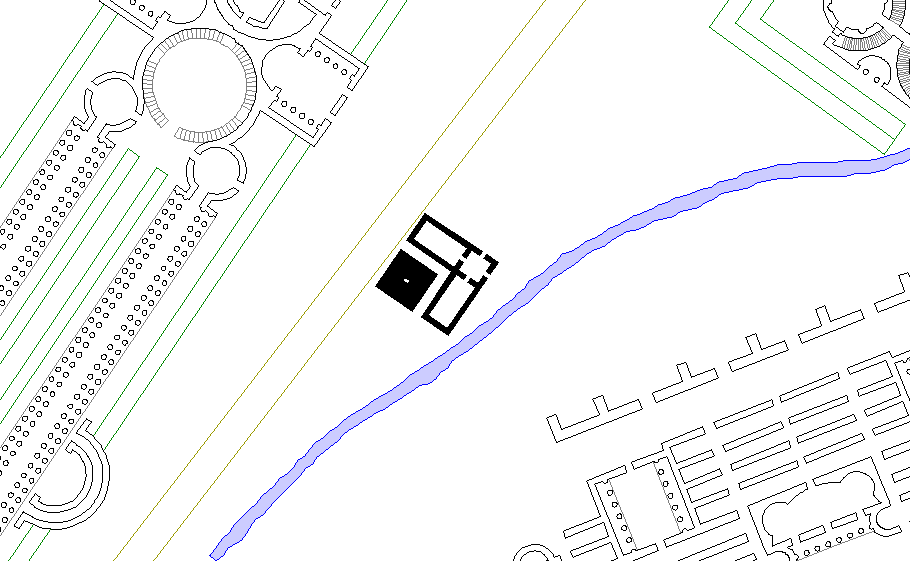Mars (Martis)
1998.07.23
Another of the Ichnographia's three major axes is the race course of the Equiria, the annual horse races held in honor of Mars. Piranesi delineates the course as a relatively straight path running the length of the Ichnographia's northern sector, beginning in the south at the Petronia Amnis (which is, however, incorrectly placed within the plan) and ultimately reaching the outskirts of Rome at the plan's edge. With the exception of a few private gardens on a hill overlooking the Equiria, all the structures along the course relate directly to the Equiria or to the military in general. Three long porticos, the Porticus a S.P.Q.R. Amoenitati Dicata, the Porticus Vipsania, and the Porticus Alexandri Severi, line the course, and no doubt are meant to accommodate the spectators of Rome's premier "fest". The buildings and areas related to the military include, the Officinae Balistarium (manufactory of ballista), Officinae Scorpiorum (manufactory of scorpions), the Naumachia Domitiani (a large amphitheater designed for the show of mock naval battles), three Circulus (large circular areas for military drills and exercises, and finally the Officinae Armorum and the Officinae machinarum militarium (manufactories of military arms and machines). Not only do these buildings pay respect to Mars as the god of war, but, as a cohesive group, they essentially constitute Rome's "Department of Defense".
| |

The Equiria (the broad gold line running from the lower left corner to the upper right corner) spans the Ichnographia's northern region, and the course itself runs in an almost true north-south direction.
|
Officinae Balistarium
Officinae Scorpiorum
1998.12.01
officina : a workshop, manufactory
ballistarium : a place where the ballista is worked
ballista : a large military engine, resembling a bow, stretched with cords and thongs, by which masses of stone and other missles were thrown to a great distance; a machine for projectiles, the ballista
scorpius: a military engine for throwing darts, stones, and other missles, a scorpion
|
The Officinae Balistarium is a small building situated near the southern point of the Equiria, on a patch of land between the Equiria and the Petronia Amnis. The building plan is a simple L-shape comprised of five rooms disposed enfilade, which partially surrounds what could be the base of a small pyramid. The Officinae Balistarium is an almost exact mirror copy of the Officinae Scorpiorum, which sits 1000 feet further up the Equiria, and together the Officinae Balistarium and Scorpiorum create a symmetrical composition with the Porticus a S.P.Q.R. Amoenitati Dicata that is on the other side of the Equiria.

Although insignificant in size, the Officinae Balistarium is nonetheless integral to Piranesi's design of the Equiria as ancient Rome's military power-base. Furthermore, the symmetrical composition of the Officinae Balistarium, the Officinae Scorpiorum and the Porticus a S.P.Q.R. Amoenitati Dicata that straddles the Equiria signifies the interdependence of "Roman pleasure" and its military machines.
| |

Officinae Balistarium

Officinae Scorpiorum
|
| |
Equiria
1998.12.01
The buildings along the Equiria related to the military are: the Officinae Balistarium, the Officinae Scorpiorium, the Templum Castrum, the Naumachia Domitiani, three Circulus with two Ludus, the Officinae Armorum with its attached Officinae machinarum militarium, the Templa Jovis Martis Veneris, and an Aedicula Isidis, all of which translate into a ballista factory, a scorpion factory, a temple dedicated to Castor (the guide to mariners), a stadium for the show of mock sea-fights, exercise fields, a factory for arms and military machines, and a triple temple dedicated to Jupiter, Mars, and Venus and chapel dedicated to Isis. These buildings, moreover, are interspersed with "statues of illustrious men" as well as the sepulchers of many distinguished military figures from Roman history. This concentration of military functions essentially constitutes a design for ancient Rome's main military headquarters.
|




